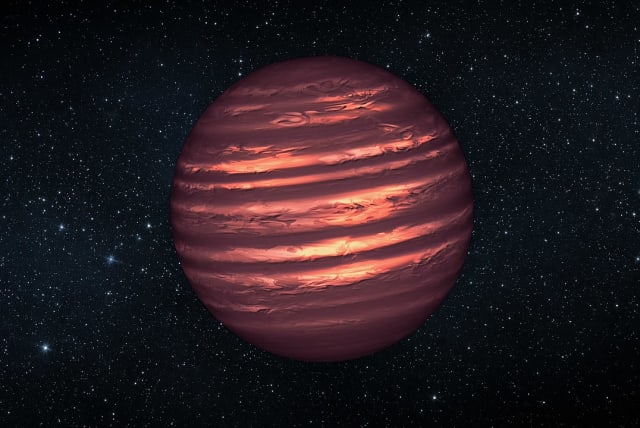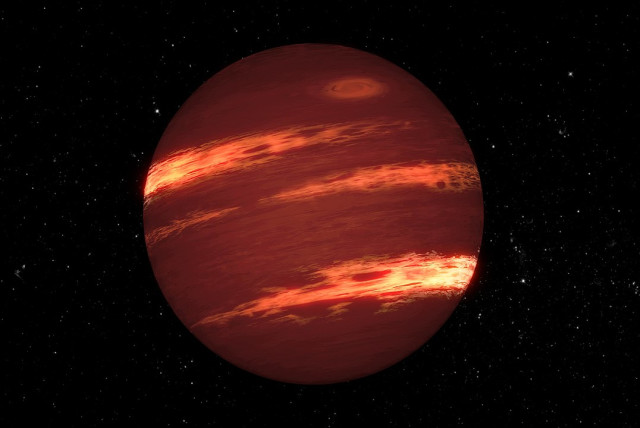Brown dwarf star just 5 times hotter than coffee found via radio waves - study

Brown dwarf star WISE J0623 was found releasing radio wave emissions. However, it is the coldest star producing radio waves ever discovered, being just 420 degrees Celsius.
Researchers have discovered the coldest star that can still produce radio waves to ever have been found, and it's just five times as hot as a fresh hot cup of coffee (served at around 85 degrees Celsius per National Institutes of Health data), according to a recent study.
Led by PhD candidate Kovi Rose of the Sydney Institute for Astronomy, this study explored WISE J0623, a brown dwarf star around the size of Jupiter.
The findings of this study were published in the peer-reviewed academic journal Astrophysical Journal Letters.
This brown dwarf star is the chillest of repeating radio burst-generating stars
A brown dwarf star is often described as being between a planet and a star, with it being somewhat difficult to describe them as one or the other. Generally speaking, they're usually way too large to be designated as gas giants, but because they're still so small, they aren't able to sustain nuclear fusion, which prevents them from becoming true stars.
If one were to try and measure the size of WISE J0623, one would find that it would be over 130 million rottweiler dogs in diameter. But the size of this brown dwarf isn't what is interesting. What matters is heat.
Heat for a star is very is a result of nuclear fusion, which creates new elements out of old ones and releases bright light and heat.
Since heat is linked to light, and the list is usually the way most stars are found, it is fairly self-explanatory to say that the hotter a star, the easier it is to find. However, brown dwarfs are much harder to find precisely because they are so relatively dim. They aren't actually brown though, but rather somewhere between orange and magenta, usually.
The fact that brown dwarfs are so hard to spot is why it took until the 1990s for one to be definitively discovered, though their existence was theorized decades prior.
However, stars also release radio waves, and this is through a different process.
These emissions are the result of electrons interacting with the star's magnetized gas. When these emissions get sent out, scientists are able to study them as being little samples of a star's atmosphere and magnetic field, which can be far easier than just looking at them directly.
However, despite the fact that all stars should in theory have plenty of radio emissions, there are only a few thousand stars we have detected to have done so in the Milky Way, a galaxy home to over 100 billion stars.
Now, why is this?
There are a number of reasons, such as the difficulty scientists have had already in detecting radio waves, or how until fairly recently, it wasn't even possible to detect radio waves from stars that weren't already very bright, based on the technology of existing radio telescopes.
However, this is starting to change. Telescope technology has advanced by leaps and bounds over the decades, and one needs to look no further than the technology used by NASA's James Webb Space Telescope to see that.
But that isn't the only advanced telescope in the world. There are plenty of others that can now detect radio wave emissions from dimmer stars. Of these telescopes, the most relevant for this case is the Australian SKA Pathfinder radio telescope. Using this, Rose and his team went over data, looking for circularly polarized radio emissions, which is when the radio waves' electrical fields spiral.
In doing so, the researchers identified WISE J0623.
But science relies on results being able to be replicated. Was WISE J0623 just a one-off mistake, or can further observations spot this brown dwarf releasing radio waves?
Utilizing other telescopes, such as the Australian Telescope Compact Array and South Africa's MeerKAT telescope, the researchers spotted two radio wave emissions releasing on a frequent basis, and every 1.9 hours, there would be two circularly polarized bursts.
This isn't the first time a brown dwarf was discovered through radio waves. In fact, due to possessing very powerful magnetic fields – WISE J0623 has a magnetic field on par with our sun – they are actually very powerful sources of radio emissions. Some of these brown dwarfs discovered through radio waves, such as WISE J0623, are known as ultracool dwarfs, due to their cooler temperatures.
And WISE J0623 is very cool, make no mistake. In an article written for The Conversation, Rose wrote that its temperature, around 420 degrees Celsius, was cooler than a commercial pizza oven. This is true.
I wonder what other units we could use to describe this ultracool dwarf star @AaronReich...
— Fun Fact Science with Kovi (@funfactscience) July 14, 2023
However, Rose also personally challenged The Jerusalem Post to come up with a better one.
To that, we would like to cite the US National Institutes of Health (NIH), which said that the average cup of coffee can be served at a temperature of as much as 85 degrees Celsius.
Doing the math, one would find that the brown dwarf star WISE J0623 is around five times hotter than a cup of coffee. So next time you drink a cup of coffee, know that your caffeinated beverage is just a fifth as hot as a star, albeit a brown dwarf star.
This temperature, along with it being the first time a brown dwarf was discovered by specifically looking for circularly polarized radio emissions, is what makes the discovery of WISE J0623 so significant.
Pretty cool, right?
Jerusalem Post Store
`; document.getElementById("linkPremium").innerHTML = cont; var divWithLink = document.getElementById("premium-link"); if (divWithLink !== null && divWithLink !== 'undefined') { divWithLink.style.border = "solid 1px #cb0f3e"; divWithLink.style.textAlign = "center"; divWithLink.style.marginBottom = "15px"; divWithLink.style.marginTop = "15px"; divWithLink.style.width = "100%"; divWithLink.style.backgroundColor = "#122952"; divWithLink.style.color = "#ffffff"; divWithLink.style.lineHeight = "1.5"; } } (function (v, i) { });


